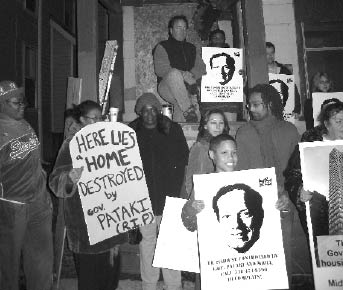Sleeper Cell
by Geoff Kelly

East Side housing activist David Torke spent Tuesday night in a sleeping bag on the porch of 28 Coe Place, a rundown Queen Anne typical of the quaint, one-block, one-way street that runs east off of Main Street, in the shadow of the $16-million Artspace renovation project.
The house is one of nearly 1,500 poster children for dereliction in the city’s most neglected neighborhoods, at the hands of the city’s worst property owners: the State of New York’s Municipal Bond Banking Agency, which bought control of the liens on these properties from the City of Buffalo two years ago. The package deal landed the cash-strapped city about $40 million and spared it the hassle of auctioning off the properties individually. The deal—in conjunction with similar deals conducted in other cities throughout the state—gave MBBA a debt portfolio, which it used to support bond issues on Wall Street. It also put MBBA in charge of a huge chunk of mostly abandoned Buffalo real estate.
The problem is, the bond issue supposed a worth to these houses that no one this side of Mars would imagine paying. JER Property Services, which MBBA hired to manage the properties for which it assumed responsibility, has not managed to sell a single property—in part because they want as much as $30,000 for a tumbledown East Side house that is worth maybe one sixth that amount, and in part because they haven’t really been trying. People who have tried to buy MBBA houses say it’s like shouting at a brick wall—no one answers. MBBA and JER haven’t rehabbed any houses, either, nor have they maintained them. The houses have been left to wither, subject to arson and the elements. MBBA’s bond issue may have given Albany a cash fix—no one has discovered yet how it was used—but it did so on the backs of 1,500 blights on Buffalo neighborhoods, most of which are already struggling.
Coe Place isn’t so much struggling as it is on the cusp of revival, thanks in part to its unique appeal and in part to Artspace, whose projects in other cities have pulled up housing values and spurred redevelopment in adjacent neighborhoods.
That’s where Dave Torke comes in. An East Side resident, Torke blogs about what he calls “demolition by neglect” in his neighborhood on his Web site, www.fixbuffalo.blogspot.com. He’s been interested in Coe Place for several years, as would be anyone who happened down this peculiar street, with its tiny lots and its quirky houses built right up to the curb. Coe Place is perfectly located to benefit from the Artspace investment—but only if people with the some money and time to invest can wrest control of properties like 28 Coe Place away from MBBA, which as an institution has demonstrated neither the capacity nor the willingness to support the neighborhoods in which it controls liens.
Torke became aware of MBBA and its Buffalo holdings—which include two houses on Coe Place—thanks to a campaign by People United for Sustainable Housing, more briefly known as PUSH Buffalo. PUSH has been working to raise awareness of MBBA and its poor property management since the spring, holding demonstrations in front of MBBA’s local offices in the Statler Building, hanging plywood boards with Governor George Pataki’s likeness on the blighted houses and staging street theater to dramatize the plights of the houses and the families that have to live around them.
Torke saw what MBBA was doing citywide and drew a connection: “I wrapped that around my interest in Coe Place,” he says, “and I tried to link together the two developments. We have in Artspace this huge public investment, and the efforts to make the most of that investment are endangered by the sort of neglect that MBBA and other public entities subject the city to.
“Coe Place is safe because it’s on the near East Side, and people have their eyes on what’s happening in Midtown, because of the Artspace development.”
But elsewhere in the city, he explains, these MBBA houses just rot, and only through the efforts of organizations like PUSH and the stunts they pull does the public learn why the city’s distressed neighborhoods keep sinking deeper into despair.
So Torke decided to engage in some theater of his own. On Tuesday night, surrounded by Coe Place residents and PUSH Buffalo members bearing signs, East Side housing activist Michelle Johnson, a member of the city’s Anti-Flipping Task Force, chained Torke to the porch of the house, where he stayed until daybreak on Wednesday. The sleepover was timed to coincide with a visit to the city by Governor-elect Eliot Spitzer, who has expressed concern about MBBA’s neglect but little knowledge of the issue. PUSH wants to extract some promises from Spitzer now, before he takes office.
“The chaining was symbolic,” Torke says. “MBBA and the State of New York are holding these neighborhoods hostage, and the Brown administration is doing nothing to address or relieve these problems.”
Word is that Spitzer and his retinue learned of the protest midafternoon on Tuesday, before Torke took up his vigil for the night. They didn’t stop by or even send hot coffee. But lots of other people did.
“There was a steady stream of visitors until about one o’clock. It was very unexpected. Lots of cider, a couple of cheeseburgers,” Torke says. He reports that he didn’t sleep too well, though it wasn’t the cold. “I was more worried about the rats moving around under the house.”
To learn more about MBBA and PUSH Buffalo’s campaign, visit www.pushbuffalo.org.
|
Issue Navigation> Issue Index > v5n46: Gift Guide (11/16/06) > Sleeper Cell This Week's Issue • Artvoice Daily • Artvoice TV • Events Calendar • Classifieds |









 Current Issue
Current Issue